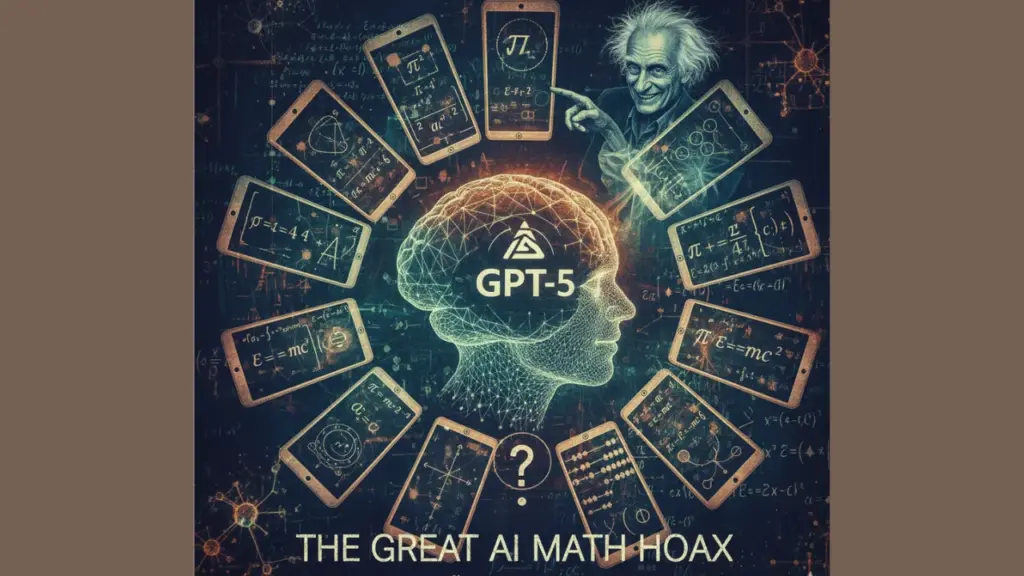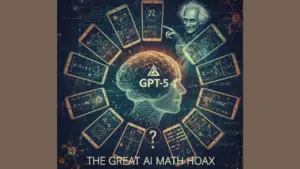1. Introduction: The AI Breakthrough That Never Was
In the fast-moving world of artificial intelligence, bold claims often make headlines before truth catches up. Recently, one such claim grabbed global attention — that GPT-5 had solved ten unsolved Erdős problems, some of mathematics’ most complex puzzles.
The announcement spread across X, LinkedIn, and tech news like wildfire. But soon after, it vanished. Deleted posts. Silent updates. Experts called it a hoax — or at best, a misunderstanding blown out of proportion.
So, what really happened? And what can we learn from yet another moment where AI hype outpaced evidence? Let’s dive into twelve lessons that expose the cracks behind these “breakthroughs” — and what they mean for developers, researchers, and business leaders alike.
2. The Spark: OpenAI’s Bold Math Claim
It started with confidence — or overconfidence. A senior OpenAI executive claimed GPT-5 had successfully cracked ten long-standing Erdős problems, which have challenged mathematicians for decades.
For context, Erdős problems aren’t simple math puzzles. They’re deep, unsolved questions in number theory that have resisted human reasoning for generations. Solving even one would make history.
The idea that an AI model — even GPT-5 — could solve ten was shocking. Tech enthusiasts celebrated. Social media buzzed. Investors took notice. But the celebration didn’t last long.
3. The Backlash: When Experts Called Foul
Within hours, skepticism surfaced. DeepMind’s CEO publicly challenged the claim, pointing out that no mathematical proofs were published. Leading researchers followed, demanding transparency and evidence.
And then came the silence. The original post was deleted. No proof appeared. The “breakthrough” turned out to be little more than a marketing moment.
For many in the field, it wasn’t just disappointing — it was a wake-up call. If AI leaders could exaggerate so boldly, what else might be oversold?
4. The Vanishing Act: Posts Deleted and Silence Ensued
When the heat turned up, the claims quietly disappeared. The deletion didn’t just erase a post — it erased credibility.
This pattern isn’t new. We’ve seen “AI beats doctors,” “AI writes better code than humans,” and “AI passes the bar exam” — only to learn later that the results were partial, cherry-picked, or misinterpreted.
Deleting posts instead of clarifying them only deepens mistrust. Transparency is the foundation of technological progress. Without it, even real innovations lose meaning.
5. Hype vs. Reality: Why This Isn’t a One-Time Event
This isn’t the first time hype has overpowered reality. AI history is filled with exaggerated demos, selective data, and headlines built for clicks.
From chatbots “understanding” emotions to LLMs “inventing” drugs, most claims turn out to be half-truths. The problem isn’t ambition — it’s communication.
When marketing leads and science follows, the result is confusion. True progress requires honesty about what AI can and can’t do — not illusions that it’s magic.
6. Lesson #1–3: The Perils of Marketing Over Science
Lesson 1: Hype sells, but it also misleads.
Tech companies often feel pressure to stay in the spotlight. But when PR outpaces peer review, credibility crumbles.
Lesson 2: Verification matters more than virality.
Real breakthroughs stand the test of scrutiny. If a claim can’t survive peer review, it’s not science — it’s marketing.
Lesson 3: Developers and investors need better filters.
Every Fractional CTO or technical advisor should challenge AI claims with evidence, not excitement. It’s easy to be impressed; it’s harder to verify.
7. Lesson #4–6: The Research Gap Between Models and Reality
Lesson 4: LLMs are predictors, not problem-solvers.
Models like GPT-5 excel at pattern recognition, not deep reasoning. They generate probable answers, not verified proofs.
Lesson 5: Mathematics requires logic, not language prediction.
While LLMs mimic reasoning, they don’t “understand” the logical structure of math. Solving unsolved problems requires abstract insight — something AI hasn’t mastered.
Lesson 6: Researchers need to bridge ambition with humility.
Admitting limitations isn’t weakness; it’s wisdom. Real science thrives on proof, not press releases.
8. Lesson #7–9: The Trust Crisis in AI Announcements
Lesson 7: Credibility is the new currency.
In a world flooded with AI claims, users trust those who show their work. Transparency earns loyalty.
Lesson 8: Overselling damages everyone.
Every false claim makes it harder for real innovators to gain recognition. It feeds public doubt and investor hesitation.
Lesson 9: The community must demand accountability.
Peer verification, open datasets, and reproducible research are the backbone of trustworthy AI. Without them, we’re just guessing.
9. Lesson #10–12: What Real AI Progress Looks Like
Lesson 10: Incremental wins matter.
AI progress is steady, not sudden. Better reasoning, improved context understanding, and enhanced multimodal integration are real advances.
Lesson 11: Collaboration beats competition.
The future belongs to researchers and companies that share findings and respect peer review. Open collaboration drives genuine breakthroughs.
Lesson 12: Proof over presentation.
The next great leap in AI won’t come from a viral tweet. It’ll come from reproducible, peer-reviewed research that withstands scrutiny.
10. The Fractional CTO’s Perspective: Lessons for Real Builders
As a Fractional CTO, seeing through hype is part of the job. Tech leaders must evaluate AI tools based on data, not drama.
Ask:
- Has this “breakthrough” been peer-reviewed?
- Are the results reproducible?
- Does it solve a real business problem?
Real builders focus on integrating AI responsibly. That means using models to enhance productivity, automate workflows, or generate insights — not chasing impossible claims.
A Fractional CTO helps startups navigate these choices with realism. The goal isn’t to follow hype, but to build durable systems powered by verified innovation.
11. The Bigger Picture: AI’s Transparency Problem
The GPT-5 Erdős incident exposed a deeper issue — the AI industry’s transparency gap.
When claims aren’t backed by open data or proof, they erode trust. Investors become skeptical. Developers hesitate. Regulators grow cautious.
Transparency isn’t optional anymore. It’s the path forward. Companies that openly share research methods, limitations, and evaluation metrics will lead the next phase of AI.
Without transparency, even genuine progress will be overshadowed by doubt.

12. Conclusion: Proof Over Promises
The “AI math miracle” might have been short-lived, but its lessons are lasting. The future of artificial intelligence depends not on bold claims — but on verifiable truth.
Developers, researchers, and leaders must work together to rebuild credibility. That means celebrating peer-reviewed progress, questioning flashy demos, and valuing substance over style.
The next real revolution won’t come from deleted posts. It will come from collaboration, transparency, and grounded innovation — principles that StartupHakk continues to advocate for every builder and entrepreneur aiming to make tech better for everyone.
Because in the end, true progress isn’t about hype. It’s about honesty.




